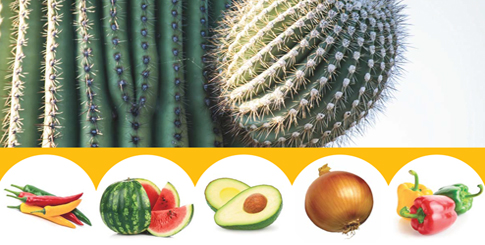Though the town may seem small and unassuming, and the walnut trees that suggested its name are not as plentiful, Nogales is a crucial player in international trade and the fresh produce supply chain.
Long after the El Camino Real and Juan Bautista de Anza Trail were blazed through the region, the Nogales-Mariposa Port of Entry became the area’s newer significant trade route. The bustling port services more than 300,000 trucks each year, bringing billions of dollars of fruits and vegetables across the border—and has come a long, long way from its original purpose.
Built in 1973 as a way to reroute traffic and keep trucks from driving through the quaint desert town, the Mariposa entryway connects to its sister town, Nogales, in the state of Sonora in Mexico. Collectively, the two are known as Ambos Nogales and serve both Americans and Mexicans in equal measure.
Nogales is also where Mexico’s federal highway 15 meets with Arizona’s state route 189, an important artery for thousands of trucks bringing produce and other goods up from Mexico to the United States, and typically returning to Mexico filled with U.S. exports of manufactured goods as well as fresh and processed vegetables.
Business Good, Even with Bad Weather
For distributors and receivers, last year was a decent year despite early weather woes in California and fall hurricanes in Texas and Florida.
The California rains delayed expected crops in the first half of the year, though luckily most were able to be replanted, harvested, and subsequently brought business back to the markets. The hurricanes, however, went much further—decimating many crops in the Southwest and Southeast.
Diego Ley Vela, general manager at Del Campo Supreme, Inc. in Nogales, still believes supply and demand will even out after better fall pricing, believing the market will stabilize soon. “Volumes will increase to normal levels after January,” he predicts.
Plantings and volume
When weather affects normal supply expectations, it impacts price and the resulting shortages tend to be an opportunity for brokers and distributors to increase margins, even with lower volume. Conversely, when the weather is perfect, commodity markets can get flooded with product, driving down prices and compressing margins.
The effects can then linger, according to Ley Vela, well beyond the immediate harvest. When growers have a harsh year, they make less money, and tend to conserve and plant less the next season, leading to lower supply and better pricing.
“The opposite happens after a good year,” notes Ley Vela, “people plant more, and this was what happened last season.” So distributors and wholesalers were anticipating a more robust 2018 in response to the normalizing effect of planting less.



